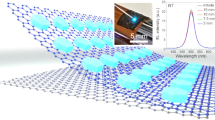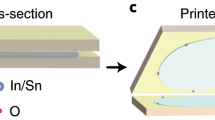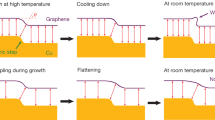Abstract
The outstanding electrical1, mechanical2,3 and chemical4,5 properties of graphene make it attractive for applications in flexible electronics6,7,8. However, efforts to make transparent conducting films from graphene have been hampered by the lack of efficient methods for the synthesis, transfer and doping of graphene at the scale and quality required for applications. Here, we report the roll-to-roll production and wet-chemical doping of predominantly monolayer 30-inch graphene films grown by chemical vapour deposition onto flexible copper substrates. The films have sheet resistances as low as ∼125 Ω □−1 with 97.4% optical transmittance, and exhibit the half-integer quantum Hall effect, indicating their high quality. We further use layer-by-layer stacking to fabricate a doped four-layer film and measure its sheet resistance at values as low as ∼30 Ω □−1 at ∼90% transparency, which is superior to commercial transparent electrodes such as indium tin oxides. Graphene electrodes were incorporated into a fully functional touch-screen panel device capable of withstanding high strain.
This is a preview of subscription content, access via your institution
Access options
Subscribe to this journal
Receive 12 print issues and online access
$259.00 per year
only $21.58 per issue
Buy this article
- Purchase on SpringerLink
- Instant access to full article PDF
Prices may be subject to local taxes which are calculated during checkout




Similar content being viewed by others
Change history
25 June 2010
In the PDF version of this Letter originally published online, the authors were listed incorrectly. This error has now been corrected.
References
Geim, A. K. & Novoselov, K. S. The rise of graphene. Nature Mater. 6, 183–191 (2007).
Lee, C., Wei, X., Kysar, J. W. & Hone, J. Measurement of the elastic properties and intrinsic strength of monolayer graphene. Science 321, 385–388 (2008).
Bunch, J. S. et al. Impermeable atomic membranes from graphene sheets. Nano Lett. 8, 2458–2462 (2008).
Elias, D. C. et al. Control of graphene's properties by reversible hydrogenation: evidence for graphene. Science 323, 610–613 (2009).
Wang, X. et al. N-doping of graphene through electrothermal reactions with ammonia. Science 324, 768–771 (2009).
Kim, K. S. et al. Large-scale pattern growth of graphene films for stretchable transparent electrodes. Nature 457, 706–710 (2009).
Kim, D.-H. et al. Stretchable and foldable silicon integrated circuits. Science 320, 507–511 (2008).
Sekitani, T. et al. A rubberlike stretchable active matrix using elastic conductors. Science 321, 1468–1472 (2008).
Reina, A. et al. Large area, few-layer graphene films on arbitrary substrates by chemical vapor deposition. Nano Lett. 9, 30–35 (2009).
Cai, W. W. et al. Large area few-layer graphene/graphite films as transparent thin conducting electrodes. Appl. Phys. Lett. 95, 123115 (2009).
Lee, Y. et al. Wafer-scale synthesis and transfer of graphene films. Nano Lett. 10, 490–493 (2010).
Caldwell, J. D. et al. Technique for the dry transfer of epitaxial graphene onto arbitrary substrates. ACS Nano 4, 1108–1114 (2010).
Li, X. et al. Large-area synthesis of high-quality and uniform graphene films on copper foils. Science 324, 1312–1314 (2009).
Ahn, S. H. & Guo, L. J. High-speed roll-to-roll nanoimprint lithography on flexible plastic substrates. Adv. Mater. 20, 2044–2049 (2008).
Yerushalmi, R., Jacobson, Z. A., Ho, J. C., Fan, Z. & Javey, A. Large scale, highly ordered assembly of nanowire parallel arrays by differential roll printing. Appl. Phys. Lett. 91, 203104 (2007).
Chang, Y. K. & Hong, F. C. The fabrication of ZnO nanowire field-effect transistors by roll-transfer printing. Nanotechnology 20, 195302 (2009).
Jo, G. et al. Etching solution for etching Cu and Cu/Ti metal layer of liquid crystal display device and method of fabricating the same. US patent, 6,881,679 (2005).
Hecht, D. S. et al. Carbon nanotube film on plastic as transparent electrode for resistive touch screens. J. Soc. Inf. Display 17, 941–946 (2009).
Li, X. et al. Transfer of large-area graphene films for high-performance transparent conductive electrodes. Nano Lett. 9, 4359–4363 (2009).
Hass, J. et al. Why multilayer graphene on 4H-SiC(000–1) behaves like a single sheet of graphene. Phys. Rev. Lett. 100, 125504 (2008).
Sprinkle, M. et al. First direct observation of a nearly ideal graphene band structure. Phys. Rev. Lett. 103, 226803 (2009).
Ferrari, A. C. et al. Raman spectrum of graphene and graphene layers. Phys. Rev. Lett. 97, 187401 (2006).
Nair, R. R. et al. Fine structure constant defines visual transparency of graphene. Science 320, 1308 (2008).
Das, A. et al. Monitoring dopants by Raman scattering in an electrochemically top-gated graphene transistor. Nature Nanotech. 3, 210–215 (2008).
Geng, H.-Z. et al. Effect of acid treatment on carbon nanotube-based flexible transparent conducting films. J. Am. Chem. Soc. 129, 7758–7759 (2007).
Schrivera, M., Reganb, W., Losterb, M. & Zettl, A. Carbon nanostructure–aSi:H photovoltaic cells with high open-circuit voltage fabricated without dopants. Solid State Commun. 150, 561–563 (2010).
Wu, J. et al. Organic light-emitting diodes on solution-processed graphene transparent electrodes. ACS Nano 4, 43–48 (2010).
Lee, J.-Y., Connor, S. T., Cui, Y. & Peumans, P. Solution-processed metal nanowire mesh transparent electrodes. Nano Lett. 8, 689–692 (2008).
Cao, H. L. et al. Electronic transport in chemical vapor deposited graphene synthesized on Cu: Quantum Hall effect and weak localization. Appl. Phys. Lett. 96, 122106 (2010).
Cairns, D. R. et al. Strain-dependent electrical resistance of tin-doped indium oxide on polymer substrates. Appl. Phys. Lett. 76, 1425–1427 (2000).
Acknowledgements
This work was supported by the National Research Foundation of Korea (NRF), funded by the Ministry of Education, Science and Technology (2009-0081966, 2009-0082608, 2009-0083540, 2009-0090017, World Class University R33-2008-000-10138-0, National Honor Scientist Program), the Research Centre of Breakthrough Technology Program through the Korea Institute of Energy Technology Evaluation and Planning (KETEP), funded by the Ministry of Knowledge Economy (2009-3021010030-11-1), Singapore National Research Foundation (NRF-RF2008-07) & NUS NanoCore, and T.J. Park Junior Faculty Fellowship. The authors thank R. Ruoff (University of Texas at Austin) and P. Kim (Columbia University) for helpful comments, W.S. Lim, K.D. Kim and Y.D. Kim (SKKU) for assistance in XPS analysis, and Samkwang Well Tech Co. for assistance with the touch-panel fabrication.
Author information
Authors and Affiliations
Contributions
B.H.H. planned and supervised the project, with assistance in supervision from J.H.A. Y.-J.K., B.O., K.S.K. and S.I. provided advice for the project. B.H.H., S.B. and H.K. conceived and carried out the experiment. B.H.H., J.H.A. and B.O. analysed the data and wrote the manuscript. X.X., J.B., Y.Z. and B.O. fabricated the QHE devices, and carried out the measurements. Y.L. and Y.I.S. helped with the fabrication of touch-screen panels and electromechanical analysis. J.S.P., H.R.K. and T.L. helped with the doping experiment.
Corresponding authors
Ethics declarations
Competing interests
The authors declare no competing financial interests.
Supplementary information
Supplementary information
Supplementary information (PDF 1412 kb)
Supplementary information
Supplementary movie (MOV 12086 kb)
Rights and permissions
About this article
Cite this article
Bae, S., Kim, H., Lee, Y. et al. Roll-to-roll production of 30-inch graphene films for transparent electrodes. Nature Nanotech 5, 574–578 (2010). https://doi.org/10.1038/nnano.2010.132
Received:
Accepted:
Published:
Issue Date:
DOI: https://doi.org/10.1038/nnano.2010.132
This article is cited by
-
Electrochemical-repaired porous graphene membranes for precise ion-ion separation
Nature Communications (2024)
-
Multispecies-coadsorption-induced rapid preparation of graphene glass fiber fabric and applications in flexible pressure sensor
Nature Communications (2024)
-
Simulation and experimental evaluation of laser-induced graphene on the cellulose and lignin substrates
Scientific Reports (2024)
-
Viscoelastic finite element analysis of roll transfer process with rate-dependent adhesion behavior and multi-element cohesive interaction
Journal of Mechanical Science and Technology (2024)
-
Transfer-free chemical vapor deposition graphene for nitride epitaxy: challenges, current status and future outlook
Science China Chemistry (2024)




